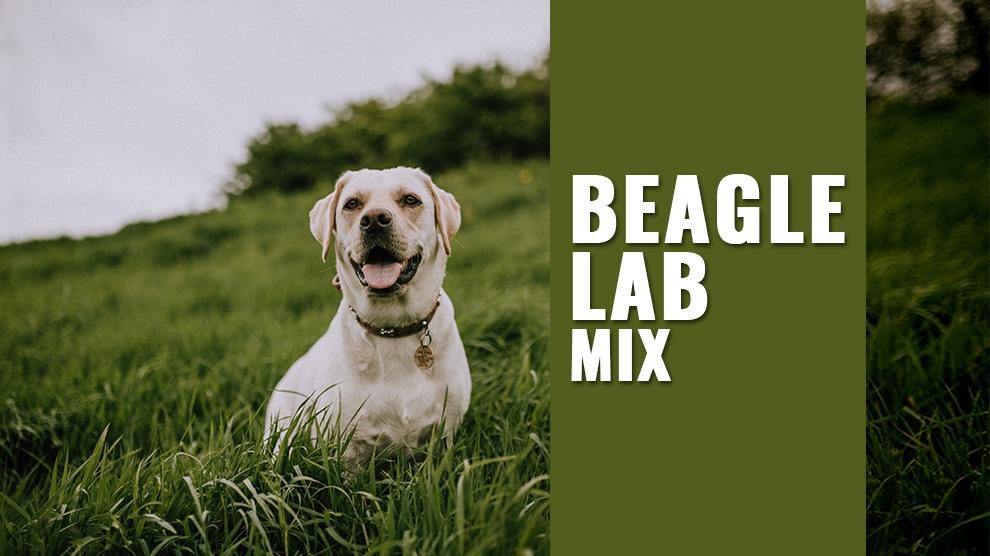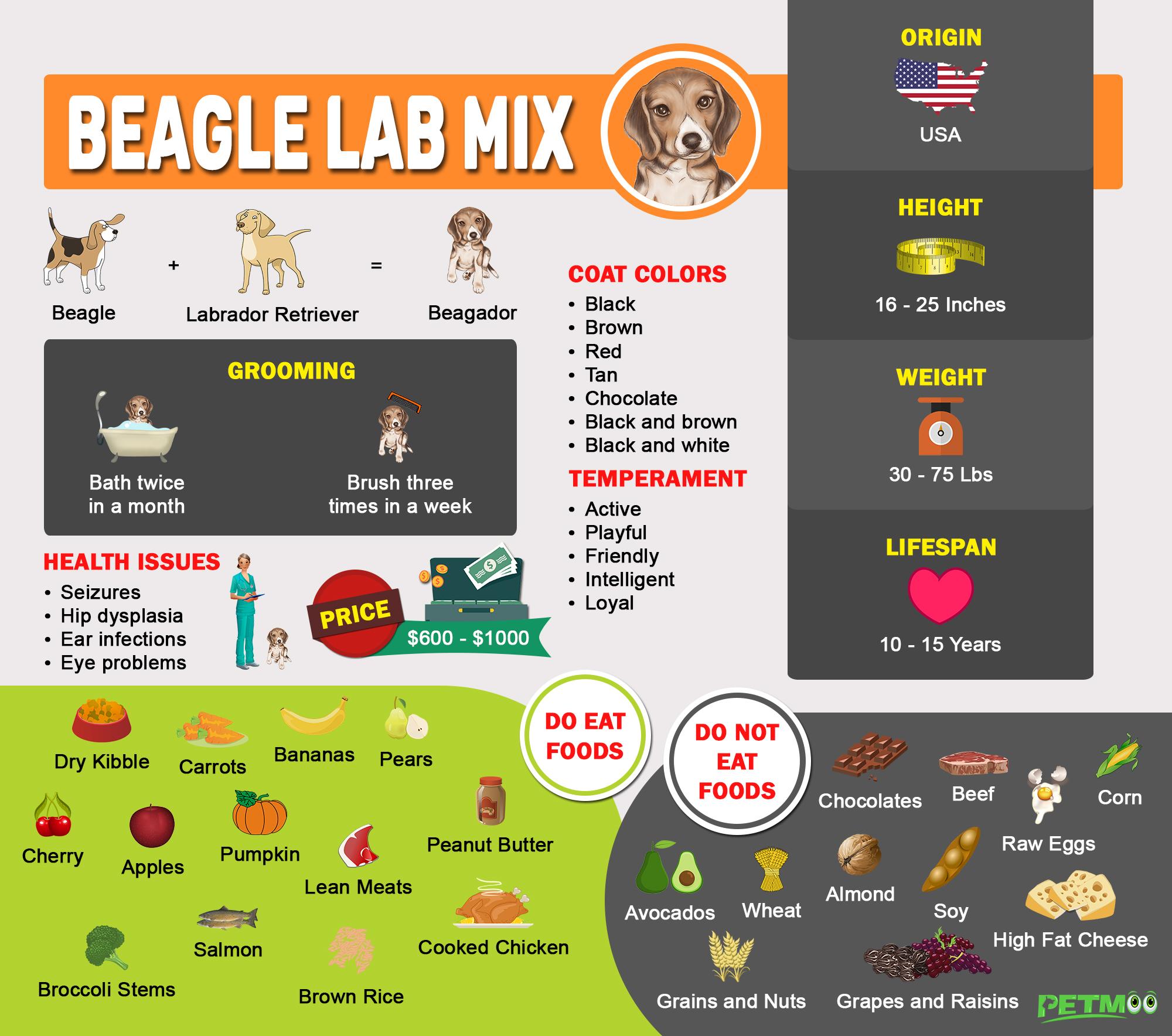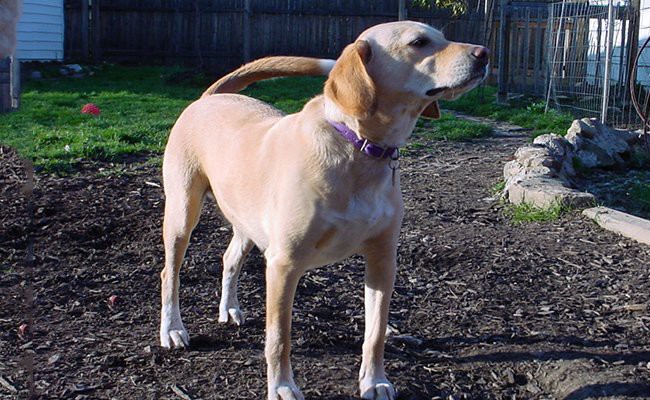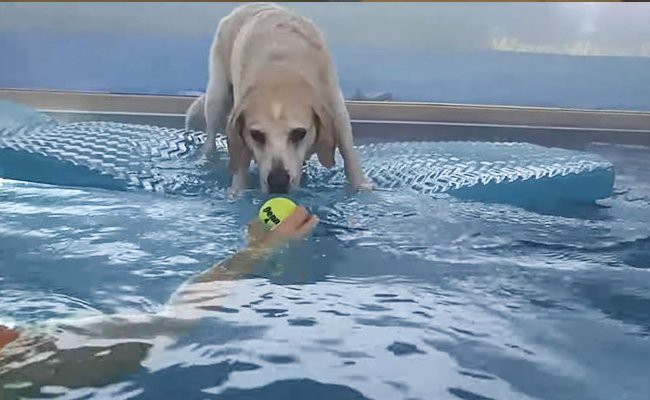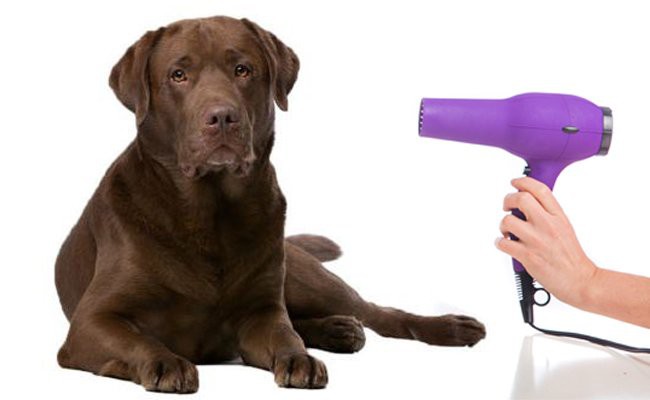Dog Pregnancy Calculator And Timeline
Called the name of Beagador, the attractive Beagle Lab Mix dog breed is crossbred between a Beagle and Labrador retriever.
Like many Beagle mixes, the Beagle Lab mix dog was initially bred in the USA and it is a very popular breed in the country for more than three decades. The Beagador is a famous dog that excels in dog sports.
Beagle Lab Mix Breed Characteristics Sheet
- Origin: United States of America
- Size: Medium
- Dog Breed Group: Sporting
- Purebred: No
- Lifespan: 10 to 15 years
- Height: 16-25 inches
- Weight: 30-75 lbs
- Coat Appearance: Short, smooth, soft, and dense
- Coat Colors: Black, Black and white, Brown, Black and brown, Red, Tan
- Temperament: Active, Playful, Friendly, Intelligent, Loyal
- Good With Children: Yes
- Intelligence Level: High
- Good With Pets: Excellent
- Hypoallergenic: No
- Grooming: Less
- Shedding: Moderate
- Barking: Rare
- Suitable For Apartments: Moderate
- Need For Exercise: High
- Easy To Train: Yes
- Good For First-Time Owners: Moderate
- Health Issues: Seizures, Hip dysplasia, Ear infections, Eye problems
- Litter Size: 4 to 6 puppies
- Average Price: $600 to $1000
Beagle And Labrador Mix
Coat Color
The Beagle Lab appears in various colors such as Black, White/Cream, black and white, black, brown, black and brown, and spotted, red and tan depending upon the Labs(Black Lab, Chocolate Lab, Yellow Lab) they are mixed with.
Beagle Lab Mix Appearance
Mostly, the Beagador has a head shape and eyes like a Beagle. This dog breed has a short and shiny coat that is similar to that of a Labrador.
A specifiable point is that the dog’s coat is water-resistant wherein which prevents the entry of various substances into the environment from entering into its body.
Beagle Lab Mix Size
The average height of a Beagle Lab mix (Beagador) dog breed can be between 16 and 25 inches. The weight of this dog breed ranges from 30 to 75 pounds.
Generally, the size, height, and weight of a dog are determined by its purebred parents.
Barking Habit
Beagle Lab mix dogs do bark but not often. The bark is similar to that of the Beagle parent.
Beagle Lab Mix Lifespan
The life expectancy range of a Beagle Lab Mix is between 10 to 15 years. Healthy dogs can only live until this age. A proper diet and good surroundings for the dog play a vital role.
There have been some cases where a few dogs of this crossbreed have survived even a couple of more years beyond the stated lifespan.
Beagle Lab Mix Temperament
- The Beagle Lab Mix dogs are very active dogs by nature and always wish to indulge in some activity. Considering this, they must be given regular exercise.
- Generally, this dog breed has an inherent playful nature and so it loves to play with small children at the house.
- It is a happy puppy that wishes to please everyone around in the house.
- This sociable dog has the quality to move to the outdoor environment.
- Normally, Beagle Lab mix dogs love to care and so they prefer to have that bonding with its family (owner’s family) members.
- The Beagle Labs are very intelligent and this quality will help the trainer/owner while giving training.
- They are good watchdogs and if it happens to find a stranger approaching the house, it will bark immediately.
- As stated earlier, the affection and care shown by its family members make the dog show utmost loyalty to them. Ultimately, this breed is a very good family dog.
Beagle Lab Mix Training
Beagador (Beagle Lab Mix ) is a dynamic dog and possesses an aggressive nature just like the Beagle parent. Hence this dog requires the needful training right from a very early age.
A highly experienced trainer will be required to train this dog and it responds well to positive training methods.
For example, offering tasty treats for doing an activity perfectly can be an effective way. A Beagador dog can be trained well by a skilled and experienced trainer.
Beagle Lab Mix Puppy Names
| Male | Female |
|---|---|
| Benji | Bobo |
| Chewy | Dakota |
| Gus | Lucy |
| Sammy | Maddie |
| Spencer | Niki |
| Turbo | Pixi |
| Alfie | Poppy |
| Ace | Twiggy |
| Alex | Zena |
| Jake | Sophie |
Beagle Lab Mix Grooming
There is no big fuss required as to how to take care of a Beagle Lab crossbreed dog since it is an easy-to-groom dog. Bathing the dog a couple of times a month will be enough.
The Beagador is a moderate shedder. It is sufficient to brush and groom the Beagador two or three times a week to make its coat appear glossy and healthy.
Beagle Lab Mix Food
Beagle Lab mix dogs do require high nutrition diet just like any other dog breed. But the Beagle Lab Mix dog is highly prone to obesity because it is extremely fond of eating.
Vet-recommended Foods for Beagle Lab Mix
- Dry Kibble
- Cherry
- Carrots
- Apples
- Bananas
- Pears
- Broccoli Stems
- Peanut butter
- Salmon
- Pumpkin
- Lean meats
- Cooked Chicken
- Brown Rice
Vet-recommended “Do not Eat Foods”
- Chocolates
- Avocados
- Cherries
- Grapes and Raisins
- High fat cheese
- Raw eggs
- Beef
- Grains and nuts
- Corn
- Soy
- Wheat
- Almond
Beagle Lab Mix Health Problems
1. Seizures
Symptoms
- Looking depressed and confused
- Body Stiffness
- Head Shaking
- Twitched muscles
- Tongue chewing
- Drooling
- Circled and unsteady walk
- Temporary vision loss
- Fall sidewards
- Loss of consciousness
- Urinary or fecal incontinence
Causes
- Erratic rise or drop in blood sugar levels
- Accidentally consume poison
- Liver disorder
- Affected Kidneys
- Electrolyte
- Head Injury
- Anemia
- Stroke
- Brain Cancer
Treatment
The dog owner/trainer must instantly carry their dog to a vet after it suffers seizures. A maximum of 5-10 minutes should only be taken. Generally, the vets give IV Valium to the dog for controlling the seizure.
The veterinarian will prescribe medicines such as Phenobarbital tablets for your dog. He may administer Phenobarbital in liquid form to the dog.
The daily dosage of Phenobarbital to the dog at least twice a day will only give the desired results. However, the Phenobarbital tablet sizes vary based on the dog’s age.
2. Hip dysplasia
Symptoms
- The looseness of the joints
- Low level of activity
- Stay away from habits like running, jumping, or climbing the stairs
- Difficulty in rising or standing up
- Swaying walk
- Handicapped rear (back) legs
- Pain in the hip joint
- Narrow stance of the hind legs
- The grating of the joints while moving
- Noticeably excess weight loss in the thigh muscles
- Limited range of body movement
- Formation of bulgy shoulder muscles due to excess pressure applied on the front legs to offset the handicap in the hind (rear) legs
Causes
- Genetic disorder
- Poor nutrition
- Exorbitant weight gain and obesity
- Pelvic muscle mass
Treatment
The vet will decide on performing surgery on the dog with hip dysplasia only after studying various factors like the dog’s age, size, and body condition.
It is only after getting satisfied with these parameters that a vet will proceed with surgery. A vet will perform the needful surgery on the affected dog.
There are four kinds of surgeries that are in practice for treating hip dysplasia.
- TPO (Triple pelvic osteotomy) surgery – The procedure for this surgery involves the cutting of the pelvis in three places. The cutting procedure is called osteotomy and this will make the pelvic socket rotate in a position such that it covers the head of the femur. After this procedure, the hip joint will become stable.
- Juvenile public symphysiodesis surgery – The surgery is done on dogs that are under six months of age where a part of the pelvis is merged to improve its hip joint stability.
- Total hip replacement surgery – Done on mature dogs that do not respond well to medications. Usually called an effective surgical method for treating hip dysplasia wherein it will largely reduce or remove the pain caused in the hip joints due to this disease. An artificial hip implant will be done after removing the original damaged hip.
- Excision Arthroplasty – In this surgery, the ball of the hip joint is removed where the muscles will do the functions of the joint.
After surgery, some anti-inflammatory drugs could be recommended by the vet to reduce inflammation and swelling. Pain medications can only reduce pain levels.
3. Ear infections
Symptoms
- The Head will be in a slightly tilted position
- Head shaking
- Brown or yellow discharge from the dog’s ears
- Bad odor due to that discharge
- Formation of crusts on the outer ear
- The dog’s ears will become reddish due to regular scratching
- Unbalanced walk
- Circled walks
- Deafness
Causes
- Nature of the dog breed and its appearance.
For example, dog breeds that have long-hanging ears can give room for the settlement of bacteria on the edges of both their ears. - Certain habits that can lead to the formation of bacteria and yeast – If dog breeds that have long ears swim or bathe in the pool for some time, the moistness in the ears will result in the growth of bacteria.
To avoid this situation, it is necessary to use a soft towel or cotton wool to swap its ears and avoid the growth of bacteria. - Diet – Food allergies are also one of the main reasons for ear infections in dogs. The dog’s diet must not contain excessive sugar and grain since this will do good for yeast.
Overgrowth of yeast will result in making the dog getting afflicted by infection. Avoid such foods in your dog’s diet. - Entry or Attack by mites and other insects on the ears of the dog – It is highly possible that mites can enter into a dog’s ears and cause irritation and more dangerous symptoms, equivalent to an ear infection.
Treatment
Use of very popular ear cleaning solutions that contain natural ingredients – This is an effective step to prevent ear infection since many natural ingredients are present in such ear cleaning solutions. It can also ensure a speedy recovery.
Try out home remedies – Use apple cider vinegar and macerated garlic for treating ear infections. Home-based treatment is the most inexpensive and reasonably effective form of treatment.
Visiting a veterinary doctor – If the above treatments for ear infections do not work for your pet, it is necessary for you to take the dog to a vet. Professional advice and treatment will be the best despite being costly and time-consuming.
4. Eye problems
There are various eye problems that a dog suffers wherein the symptoms, causes and treatment will differ accordingly.
Symptoms
- Feeling irritation in the eyes
- Scratching/rubbing eyes
- Discharge of mucus from the eyes
- Squinting of the eye/s
- Cloudy film-like appearance on the eyes
- Bulging eyes
- Excessive tearing
- Swelling of the eyeball or eyelids
- Hair Loss
Causes
- Allergies
- Trauma
- Injury
- Corneal Ulcer
- Inner eyelid disorders
- Conjunctivitis
- Immune system disorders
- Congenital (at the time of birth) problems
- Virus
Treatment
Dogs with eye discharge or reddish eyes must definitely be taken to a veterinary doctor for a complete exam. Otherwise, topical antibiotics are given for dogs with the corneal ulcer.
Dogs in the advanced stage of any eye disease will be subject to surgery by the veterinarian. Factors like the age and the health situation of the dog will be looked into by a vet to find out if the dog has the strength to undergo surgery.
Based on the results, the vet will decide on how to handle it.
Beagle Lab Mix Interesting Facts
- The Beagle Lab mix dogs are very athletic and can easily escape if there is no high protective fencing around the home.
- They are very smart, intelligent, and fast learners. They always strive hard to please their owners.
- Beagle mix dog breeds do not bark much.
Beagle Lab Mix Price
The Beagle Lab mix (Beagador) can be purchased for a price of $600 to $1000 or maybe above. The major price determinants are the parents of the Lab Beagle Mix and the breeder’s experience and goodwill value in the market.
However, the age of the dog, vaccination detail, and its location of purchase (statewide) can even determine the mixed dog breed’s purchase cost.

